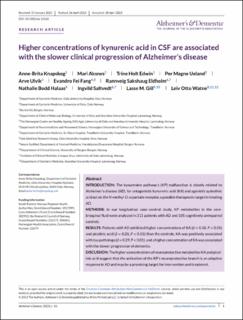| dc.contributor.author | Knapskog, Anne Brita | |
| dc.contributor.author | Aksnes, Mari | |
| dc.contributor.author | Edwin, Trine Holt | |
| dc.contributor.author | Ueland, Per Magne | |
| dc.contributor.author | Ulvik, Arve | |
| dc.contributor.author | Fang, Fei | |
| dc.contributor.author | Eldholm, Rannveig Sakshaug | |
| dc.contributor.author | Halaas, Nathalie Bodd | |
| dc.contributor.author | Saltvedt, Ingvild Tina | |
| dc.contributor.author | Solvang, Stein-Erik Hafstad | |
| dc.contributor.author | Watne, Leiv | |
| dc.date.accessioned | 2023-07-18T14:21:23Z | |
| dc.date.available | 2023-07-18T14:21:23Z | |
| dc.date.created | 2023-06-22T13:30:50Z | |
| dc.date.issued | 2023 | |
| dc.identifier.citation | Alzheimer's & Dementia. 2023, . | en_US |
| dc.identifier.issn | 1552-5260 | |
| dc.identifier.uri | https://hdl.handle.net/11250/3079724 | |
| dc.description.abstract | INTRODUCTION
The kynurenine pathway's (KP) malfunction is closely related to Alzheimer's disease (AD), for antagonistic kynurenic acid (KA) and agonistic quinolinic acid act on the N-methyl-D-aspartate receptor, a possible therapeutic target in treating AD.
METHODS
In our longitudinal case–control study, KP metabolites in the cerebrospinal fluid were analyzed in 311 patients with AD and 105 cognitively unimpaired controls.
RESULTS
Patients with AD exhibited higher concentrations of KA (β = 0.18, P < 0.01) and picolinic acid (β = 0.20, P < 0.01) than the controls. KA was positively associated with tau pathology (β = 0.29, P < 0.01), and a higher concentration of KA was associated with the slower progression of dementia.
DISCUSSION
The higher concentrations of neuroprotective metabolites KA and picolinic acid suggest that the activation of the KP's neuroprotective branch is an adaptive response in AD and may be a promising target for intervention and treatment.
Highlights
Patients with Alzheimer's disease (AD) exhibited higher concentrations of kynurenic acid and picolinic acid than controls.
Higher concentrations of kynurenic acid were associated with slower progression of AD.
Potential neurotoxic kynurenines were not increased among patients with AD.
Activation of the kynurenine pathway's neuroprotective branch may be an adaptive response in AD. | en_US |
| dc.language.iso | eng | en_US |
| dc.publisher | Wiley | en_US |
| dc.rights | Attribution-NonCommercial-NoDerivatives 4.0 Internasjonal | * |
| dc.rights.uri | http://creativecommons.org/licenses/by-nc-nd/4.0/deed.no | * |
| dc.title | Higher concentrations of kynurenic acid in CSF are associated with the slower clinical progression of Alzheimer's disease | en_US |
| dc.title.alternative | Higher concentrations of kynurenic acid in CSF are associated with the slower clinical progression of Alzheimer's disease | en_US |
| dc.type | Peer reviewed | en_US |
| dc.type | Journal article | en_US |
| dc.description.version | publishedVersion | en_US |
| dc.source.pagenumber | 0 | en_US |
| dc.source.journal | Alzheimer's & Dementia | en_US |
| dc.identifier.doi | 10.1002/alz.13162 | |
| dc.identifier.cristin | 2157134 | |
| cristin.ispublished | true | |
| cristin.fulltext | original | |
| cristin.qualitycode | 1 | |

